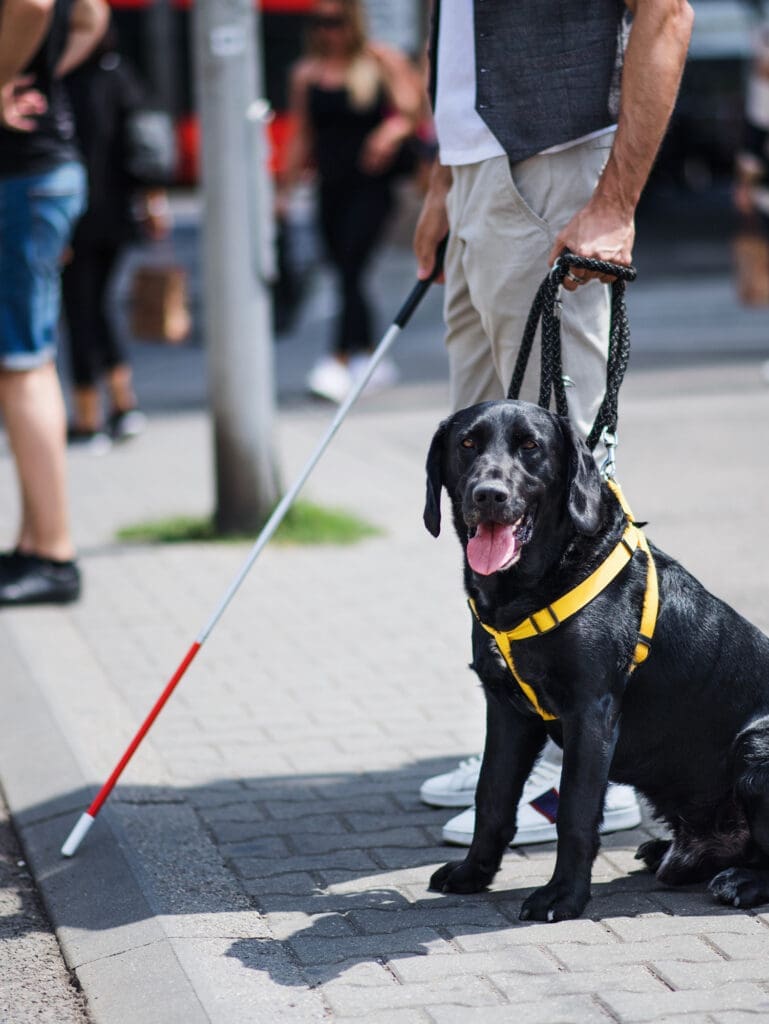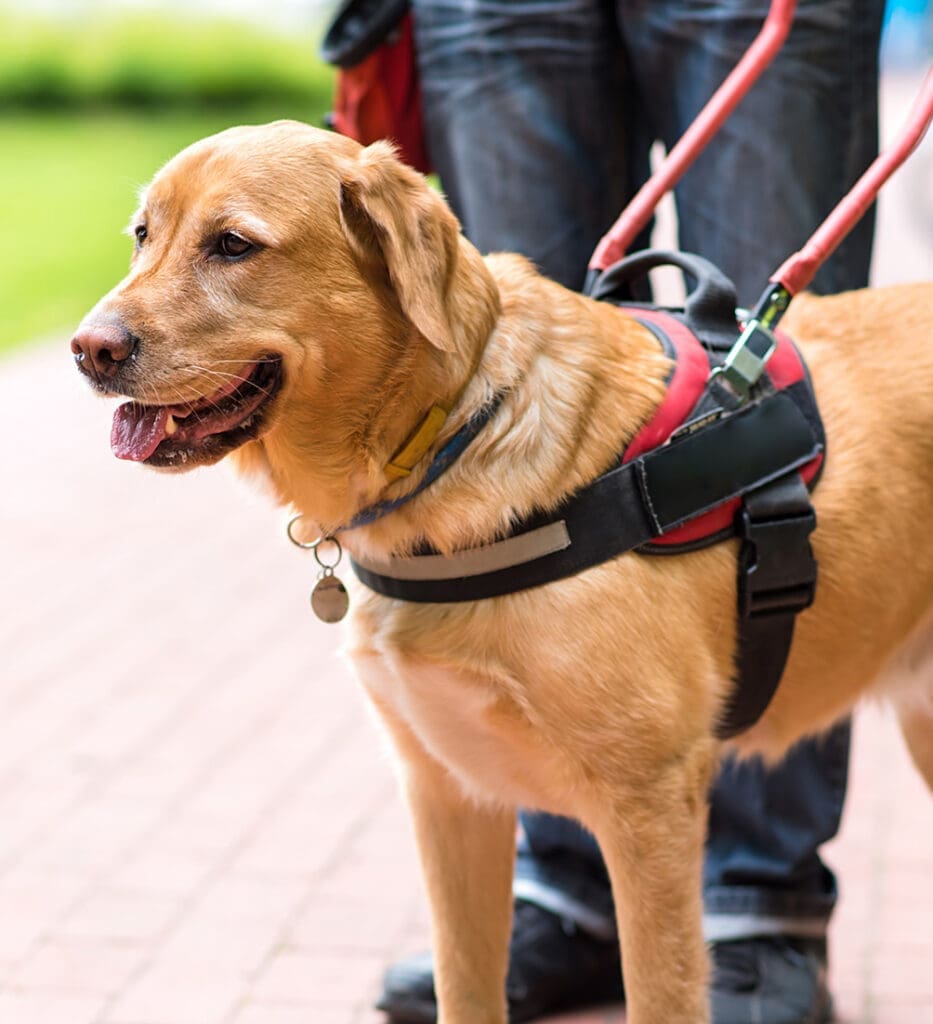Service Dog Guide: Everything You Need to Know
Service dogs have been around for hundreds of years. In the past, they were used to help people on farms, hunt, guide the blind, and much more. Today, service dogs have become more specialized, and there are more options than ever. Plus, federal and state governments have passed several laws to protect service dogs and allow them to accompany their owners in public spaces and apartments where pets usually aren’t allowed.
That said, it’s important to know what a service dog is and to understand more about how they can help before you try to adopt one. You’ll need to know how they’re trained, how long they can serve, and the types of disabilities they can help you manage. Thankfully, we’re here to help you learn everything you need about these canine companions.
Read on to learn more below.
What Is a Service Dog?
People with disabilities can qualify for a service dog. The requirements vary by state, but the ADA is lenient about who can qualify. First and foremost, an individual must prove that they have a disability that qualifies for a service dog. These disabilities can be mental or physical, but the important part is that a service dog has to be able to improve the condition.
For example, a person must prove that they can’t get food or water on their own without a service dog or that getting these things with a service dog would be easier. This also applies to medications, mobility, and mental health disabilities.
While proving that you have a disability that requires a service dog is the first step, the ADA needs more than just your word. You’ll have to visit a doctor and have them recommend a service dog for treatment or mention that a service dog can help with your disability. This shouldn’t be challenging, and a visit to your primary care physician or psychologist is usually enough to get the approval you need.


Who Qualifies for a Service Dog?
People with disabilities can qualify for a service dog. The requirements vary by state, but the ADA is lenient about who can qualify. First and foremost, an individual must prove that they have a disability that qualifies for a service dog. These disabilities can be mental or physical, but the important part is that a service dog has to be able to improve the condition.
For example, a person must prove that they can’t get food or water on their own without a service dog or that getting these things with a service dog would be easier. This also applies to medications, mobility, and mental health disabilities.
While proving that you have a disability that requires a service dog is the first step, the ADA needs more than just your word. You’ll have to visit a doctor and have them recommend a service dog for treatment or mention that a service dog can help with your disability. This shouldn’t be challenging, and a visit to your primary care physician or psychologist is usually enough to get the approval you need
What Protections Does a Service Dog Have?
Service dogs have protections that allow them to go into public because of the Americans with Disabilities Act (ADA). That said, there are also other protections in place for service dogs. The Fair Housing Act (FHA) allows service dogs to remain in otherwise non-pet-friendly apartments, and the Air Carrier Access Act (ACAA) allows service dogs to board planes in the passenger section instead of the cargo hold.
For these reasons, service dogs can go just about anywhere. You don’t have to worry about being asked any questions either because service dog laws only allow people to ask you if the service dog is used for disability and the type of training they have.
How Long Can a Service Dog Serve?
A good rule of thumb to follow is that a service dog’s working career will last between eight to ten years. That said, several factors influence when a service dog should retire. Once they can’t help you with tasks, have less energy, or begin having their own disabilities to manage, it’s time to retire your service dog.
Thankfully, you don’t have to part ways with your companion and can keep them as a pet. It’s also important to note that some service dog schools will have limits on how old a service dog can be, and they may require you to retire the dog, even if you don’t think it’s time.
Does a Service Dog Need a Vest?
When you see a service dog in public, there’s a good chance that they’re wearing a vest. However, that doesn’t mean a service dog is legally required to have one. In fact, the ADA doesn’t have any rules that state that a service dog should wear a vest.
That said, having your service dog wear a vest is still a good idea. Some of the benefits of having them in a vast include:
- Fewer interruptions in public
- It helps keep other people comfortable
- Pockets for storing things like medications, snacks, or food
- Handles for extra support or easy change of direction
While it’s not required, the benefits are often worth it when it comes to service dog vests.
Is an Emotional Support Animal a Service Dog?
No, emotional support animals (ESA) are not service animals. While they can provide a service for someone and relieve someone of mental distress, they don’t fall under the same category as a service dog. What makes ESAs different is the fact that they don’t have to have any training. This means that any animal can be an ESA as long as they are not destructive or aggressive.
That said, ESAs are only protected under the Fair Housing Act (FHA), and do not have any protections outlined by the ADA or Air Carrier Access Act (ACAA). For these reasons, a service dog and emotional support animal don’t fall into the same category.
It’s also important to note that you should never put a service dog vest on an ESA or lie about an ESA about being a service dog. This can result in fines or even jail time.


Is a Therapy Dog a Service Dog?
No, therapy dogs are not service dogs. Therapy dogs are a unique type of dog trained to help people by comforting groups in situations where they may need it. These places can include schools, hospitals, nursing homes, and other places where people experience emotions.
In most cases, therapy dogs are trained to calm someone’s emotions. They can interact with a group of people instead of being bonded with one person—this is what makes them different from an ESA.
Therapy dogs may also have some training to perform techniques like deep pressure therapy (DPT), but this isn’t legally required. That said, therapy dogs don’t have protection from the ADA or ACAA, so they’re closer to an ESA in that sense.
What Are the Best Service Dog Breeds?
Service dogs come in many shapes and sizes. Plus, there are no restrictions on the type of breed that a service dog can be.
Learn about some of the best breeds for service dogs below.
1. Labrador Retriever
The Labrador retriever is one of the best service dog breeds around. They’re emotionally intelligent, smart enough to learn complex commands, and big enough to move wheelchairs or open doors.
Plus, Labrador retrievers also have a calm temperament (once they’re fully matured), which makes them perfect for training and keeps them calm in public. After all, there’s a reason that the majority of service dogs are Labrador retrievers.
Overall, Labrador retrievers are a great fit because they’re athletic, hardy, and able to keep up with people.
2. Bernese Mountain Dog
The Bernese mountain dog is another great choice for service dogs because of its size and trainability. While these dogs are massive, they’re easy to train and suitable for most physical tasks. They can pull wheelchairs, open doors, fetch medications, and do just about anything you ask of them.
The only drawback of this breed is that they’re too big for some public spaces. However, if you need physical assistance, this is something you can overlook.
3. German Shepherd
Since its introduction, the German shepherd has been a staple of service dog work. The breed is unique because it’s easy to train and smart enough to learn most commands. You’ll commonly see these dogs used in police work, but they can also handle physical tasks and even emotionally bond with their owners.
The German shepherd’s drawback is that they don’t always have a calm temperament, which can lead to problems if they’re not well-trained and socialized. Thankfully, most service dog training will address these issues.
4. Golden Retriever
The golden retriever has become a staple of service dog work. These dogs are friendly, emotionally intelligent, and easy to train. This makes them perfect for working in large groups without getting distracted, and they’re strong enough to perform most types of physical labor.
Golden retrievers are also abundant, so you don’t have to worry about paying top dollar for a dog or waiting for the breed that you need.
The last thing to note about golden retrievers is that they’re eager to please their companions. This makes them easier to train and more pleasant to be around.
5. Poodle
Another great breed, the poodle, is perfect for service dog work. Poodles were originally bred to handle harsh terrain, but in modern times, they’re biggest appeal is that they’re smart enough to bond with their owners and learn a wide range of commands. This makes them perfect for most types of service dog work, and their medium size makes it easy for them to get around.
While they might not be as fluffy or friendly as a golden retriever, they make great service dogs for their intelligence and ability to bond with their owners. Poodles also make great service dogs because they don’t shed a lot. If you’re looking for a service dog with low maintenance, you can’t beat a poodle.
What Disabilities Can a Service Dog Help With?
Service dogs can help with a handful of disabilities, which can range in severity. Service dogs with enough emotional intelligence can even prevent or anticipate panic attacks, flashbacks, and other mental health conditions.
Learn more about the types of disabilities that service dogs can help with below.
Mental Health Disabilities
Mental health disabilities impact millions of people around the world. Whether it’s a post-traumatic issue or a problem with anxiety, there’s a good chance that a service dog can help.
Service dogs can help with mental disabilities because of their emotional intelligence and ability to bond with their owners. In fact, service dogs are often assigned to veterans because of conditions like post-traumatic stress disorder (PTSD).
Service dogs can also help with other mental health disabilities. They can help people who have panic attacks by providing deep pressure therapy (DPT), which helps people calm down when they’re under pressure from anxiety or depression. Some service dogs can also help with social anxiety by acting as an icebreaker in public crowds.
Also, service dogs are unique because they can go beyond what medications provide for treatment. This means that they can escort people out of situations that induce anxiety or panic attacks. Plus, they can get help for people if they’re having an attack and ensure that the proper treatment is delivered.
Allergies
Some service dogs are trained to help people who have allergies. Service dogs can smell a potential allergen, which can prevent someone from encountering that allergen. This can reduce the risk of allergy attacks.
Additionally, service dogs can grab EpiPens for people who have been stung by bees or people who have been around allergens that cause significant health problems. That said, service dogs for allergies are usually only utilized by people who have severe allergies that can cause life-threatening health conditions.
Mobility Assistance
One of the most common uses for service dogs is mobility problems. This applies to people who are blind, who are physically unable to walk, or who have paralysis. Service dogs trained to help with mobility can move wheelchairs through harsh terrain, open doors, and perform other physical tasks.
Mobility assistance can also apply to several other conditions. For example, they can help someone with cerebral palsy balance due to handles on a harness. Ultimately, the options are limitless depending on the person’s condition and the dog’s training. For example, physical disability service dogs can even help someone balance if they can’t stand or walk properly on their own.
Seizures
A unique type of service dog is the seizure-alert dog. While there isn’t much research about how dogs can prevent or observe seizures, some studies have shown that dogs can help someone get through a seizure. They can use a K-9 phone to call for help or get help from a person if they don’t have access to one. S
Some seizure-alert dogs can also sense when a seizure is about to happen and move someone onto their side if they believe that they’ll vomit.
Diabetes
Service dogs can also be trained to help with conditions like diabetes. They can sense when a person’s blood sugar is too low or too high, which can help them notify people if they faint. Service dogs for diabetes can also help by carrying insulin or snacks that increase blood sugar for people who may need the assistance.
What’s more, service dogs for diabetes can carry K-9 phones that alert the authorities when their owner is having an issue.
Hearing Disabilities
People who cannot hear well or are deaf are also eligible for a service dog. In these cases, the service dog acts as the person’s ears. If an event causes distress or danger, the dog can alert the person to evacuate the area.
When it comes to their training, hearing dogs are usually treated in a specific way that helps them respond to specific noises. This helps the dog alert the person to only the types of noise that matter the most instead of getting their attention for any sign of noise or other problems.
Autism Service Dogs
Another common type of service dog is a service dog that can help with a condition like autism. Autism can be a physical or mental condition, so it’s not uncommon for service dogs to be trained in a way that helps with both circumstances. Service dogs for autism can help students learn in school by making them more comfortable or helping students move around if they’re unable to.
Autism service dogs are also great for helping people with social anxiety. They can make it easier for people with autism to converse with people, and they’ve been shown to help with development in some cases.
Get a Service Dog Today
Service dogs can make a huge impact on someone’s life, especially if they have a significant disability. They can help you manage your emotions, prevent panic attacks, and even help people who can’t see or hear navigate their surroundings.
While there is a lot to learn about service dogs, the information in our article is sufficient to get you started. When it’s time to register your service dog or train a service dog, check out some of our other resources to begin the process.




